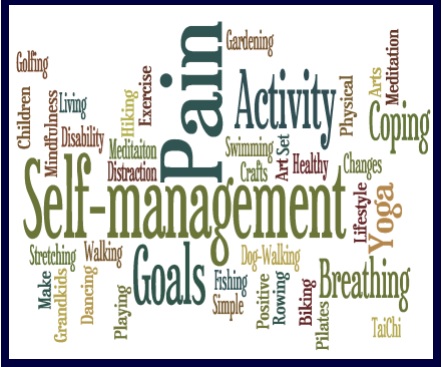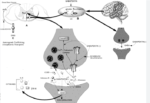Coping techniques for chronic pain begin with controlled deep breathing, as follows:
- Try putting yourself in a relaxed, reclining position in a dark room. Either shut your eyes or focus on a point.
- Then begin to slow down your breathing. Breathe deeply, using your chest. If you find your mind wandering or you are distracted, then think of a word, such as the word “Relax,” and think it in time with your breathing…the syllable “re” as you breathe in and “lax” as you breathe out.
- Continue with about 2 to 3 minutes of controlled breathing.
- Once you feel yourself slowing down, you can begin to use imagery techniques.

The effect of deep and slow breathing on pain perception, autonomic activity, and mood processing–an experimental study
Abstract
Objective: Deep and slow breathing (DSB) techniques, as a component of various relaxation techniques, have been reported as complementary approaches in the treatment of chronic pain syndromes, but the relevance of relaxation for alleviating pain during a breathing intervention was not evaluated so far.
Methods: In order to disentangle the effects of relaxation and respiration, we investigated two different DSB techniques at the same respiration rates and depths on pain perception, autonomic activity, and mood in 16 healthy subjects. In the attentive DSB intervention, subjects were asked to breathe guided by a respiratory feedback task requiring a high degree of concentration and constant attention. In the relaxing DSB intervention, the subjects relaxed during the breathing training. The skin conductance levels, indicating sympathetic tone, were measured during the breathing maneuvers. Thermal detection and pain thresholds for cold and hot stimuli and profile of mood states were examined before and after the breathing sessions.
Results: The mean detection and pain thresholds showed a significant increase resulting from the relaxing DSB, whereas no significant changes of these thresholds were found associated with the attentive DSB. The mean skin conductance levels indicating sympathetic activity decreased significantly during the relaxing DSB intervention but not during the attentive DSB. Both breathing interventions showed similar reductions in negative feelings (tension, anger, and depression).
Conclusion: Our results suggest that the way of breathing decisively influences autonomic and pain processing, thereby identifying DSB in concert with relaxation as the essential feature in the modulation of sympathetic arousal and pain perception.
chronic pain control techniques
Eleven specific imagery and chronic pain control techniques that are effective for pain control include:
- Altered focus
This is a favorite technique for demonstrating how powerfully the mind can alter sensations in the body. Focus your attention on any specific non-painful part of the body (hand, foot, etc.) and alter sensation in that part of the body. For example, imagine your hand warming up. This will take the mind away from focusing on the source of your pain, such as your back pain. - Dissociation
As the name implies, this chronic pain technique involves mentally separating the painful body part from the rest of the body, or imagining the body and mind as separate, with the chronic pain distant from one’s mind. For example, imagine your painful lower back sitting on a chair across the room and tell it to stay sitting there, far away from your mind. - Sensory splitting
This technique involves dividing the sensation (pain, burning, pins and needles) into separate parts. For example, if the leg pain or back pain feels hot to you, focus just on the sensation of the heat and not on the hurting. - Mental anesthesia
This involves imagining an injection of numbing anesthetic (like Novocain) into the painful area, such as imagining a numbing solution being injected into your low back. Similarly, you may then wish to imagine a soothing and cooling ice pack being placed onto the area of pain. - Mental analgesia
Building on the mental anesthesia concept, this technique involves imagining an injection of a strong pain killer, such as morphine, into the painful area. Alternatively, you can imagine your brain producing massive amount of endorphins, the natural pain relieving substance of the body, and having them flow to the painful parts of your body. - Transfer
Use your mind to produce altered sensations, such as heat, cold, anesthetic, in a non-painful hand, and then place the hand on the painful area. Envision transferring this pleasant, altered sensation into the painful area. - Age progression/regression
Use your mind’s eye to project yourself forward or backward in time to when you are pain-free or experiencing much less pain. Then instruct yourself to act “as if” this image were true. - Symbolic imagery
Envision a symbol that represents your chronic pain, such as a loud, irritating noise or a painfully bright light bulb. Gradually reduce the irritating qualities of this symbol, for example dim the light or reduce the volume of the noise, thereby reducing the pain. - Positive imagery
Focus your attention on a pleasant place that you could imagine going – the beach, mountains, etc. – where you feel carefree, safe and relaxed. - Counting
Silent counting is a good way to deal with painful episodes. You might count breaths, count holes in an acoustic ceiling, count floor tiles, or simply conjure up mental images and count them. - Pain movement
Move chronic back pain from one area of your body to another, where the pain is easier to cope with. For example, mentally move your chronic back pain slowly into your hand, or even out of your hand into the air.
Some of these techniques are probably best learned with the help of a professional, and it usually takes practice for these techniques to become effective in helping alleviate chronic pain. It is often advisable to work on pain coping strategies for about 30 minutes 3 times a week. With practice, you will find that the relaxation and chronic pain control become stronger and last longer after you are done.




